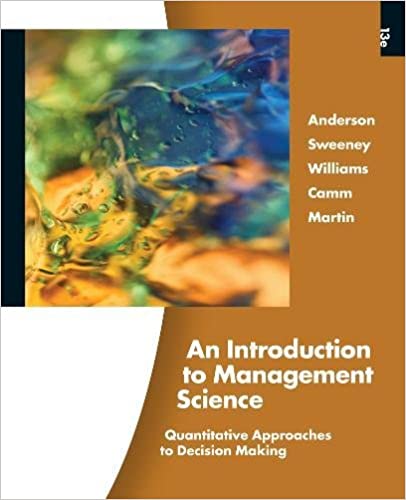
An Introduction to Management Science 13th Edition by David Anderson,Dennis Sweeney ,Thomas Williams ,Jeffrey Camm, Kipp Martin
Edition 13ISBN: 978-1439043271
An Introduction to Management Science 13th Edition by David Anderson,Dennis Sweeney ,Thomas Williams ,Jeffrey Camm, Kipp Martin
Edition 13ISBN: 978-1439043271 Exercise 5
A major traffic problem in the Greater Cincinnati area involves traffic attempting to cross the Ohio River from Cincinnati to Kentucky using Interstate 75. Let us assume that the probability of no traffic delay in one period, given no traffic delay in the preceding period is 0.85 and that the probability of finding a traffic delay in one period, given a delay in the preceding period, is 0.75 Traffic is classified as having either a delay or a no-delay state, and the period considered is 30 minutes.
a. Assume that you are a motorist entering the traffic system and receive a radio report of a traffic delay. What is the probability that for the next 60 minutes (two time periods) the system will be in the delay state? Note that this result is the probability of being in the delay state for two consecutive periods.
b. What is die probability that in the long run the traffic will not be in the delay state?
c. An important assumption of the Markov process models presented in this chapter has been the constant or stationary transition probabilities as the system operates in the future. Do you believe this assumption should be questioned for this traffic problem? Explain.
a. Assume that you are a motorist entering the traffic system and receive a radio report of a traffic delay. What is the probability that for the next 60 minutes (two time periods) the system will be in the delay state? Note that this result is the probability of being in the delay state for two consecutive periods.
b. What is die probability that in the long run the traffic will not be in the delay state?
c. An important assumption of the Markov process models presented in this chapter has been the constant or stationary transition probabilities as the system operates in the future. Do you believe this assumption should be questioned for this traffic problem? Explain.
Explanation
Markov Process:
Markov process models a...
An Introduction to Management Science 13th Edition by David Anderson,Dennis Sweeney ,Thomas Williams ,Jeffrey Camm, Kipp Martin
Why don’t you like this exercise?
Other Minimum 8 character and maximum 255 character
Character 255


